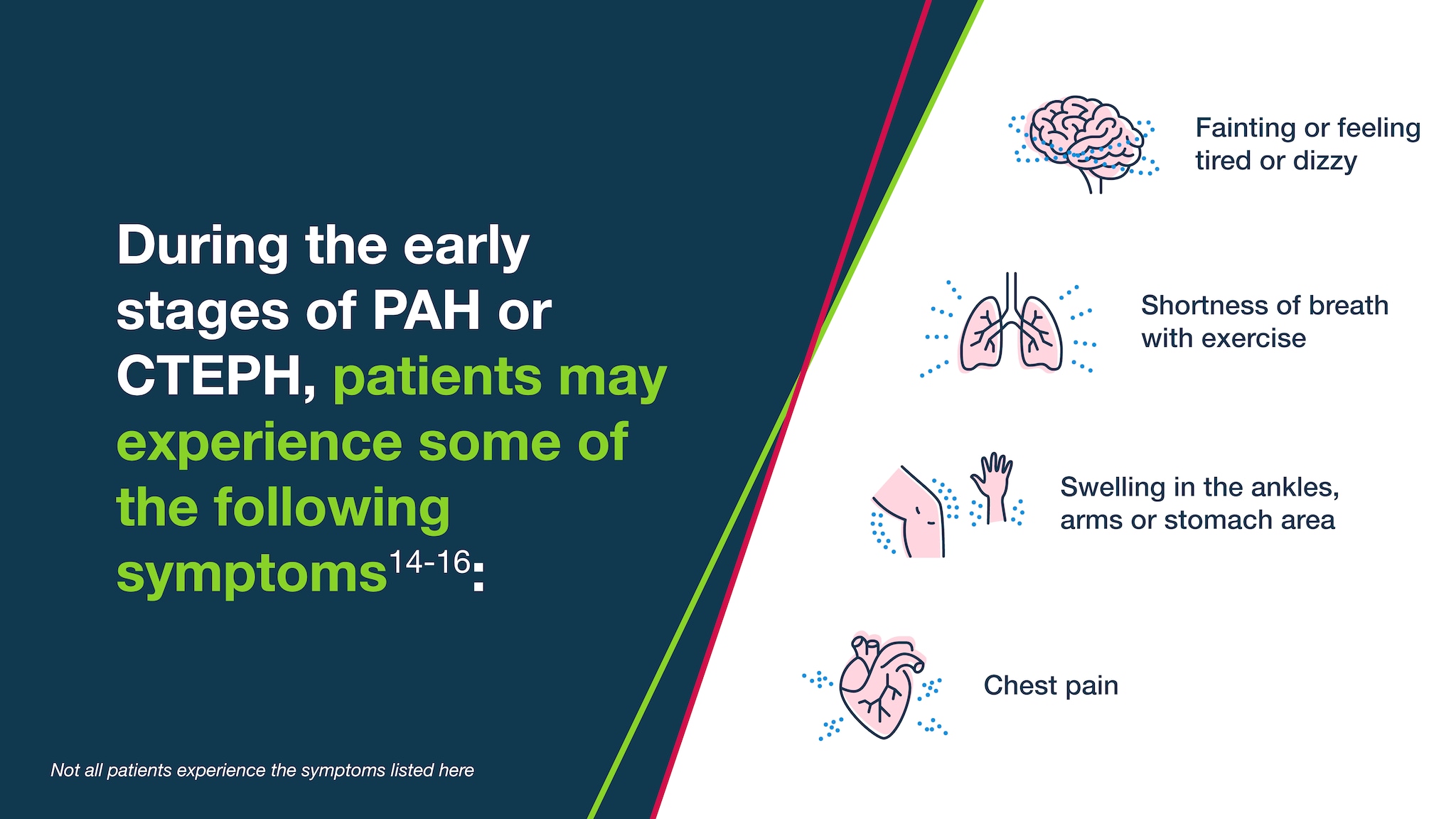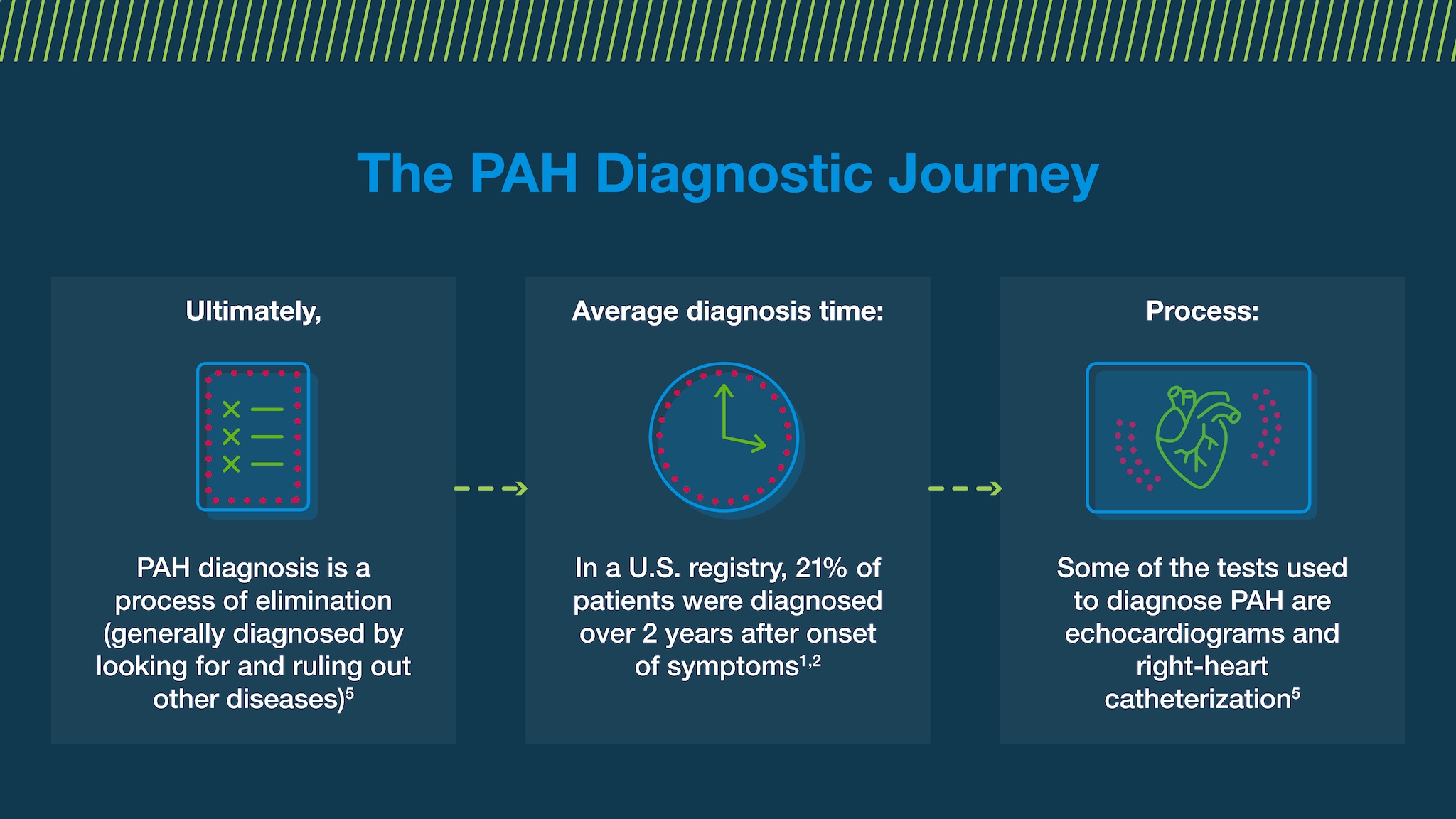Bringing Pulmonary Hypertension to the Forefront

- This Is Bayer
- Agriculture
- Consumer Health
- Pharmaceuticals
- Products
- Community
- News & Stories
- Careers
- This Is Bayer
- Agriculture
- Consumer Health
- Pharmaceuticals
- Products
- Community
- News & Stories
- Careers
Pulmonary arterial hypertension (PAH) and chronic thromboembolic pulmonary hypertension (CTEPH) are rare conditions in which high blood pressure occurs in the arteries (blood vessels) of the lungs, which can lead to heart failure.1-3 Early diagnosis may improve patient outcomes, but diagnosis and treatment delays are common because the main symptoms are not specific to PAH or CTEPH.4,5
Diagnosis Impacts and Challenges
Pulmonary arterial hypertension (PAH) and chronic thromboembolic pulmonary hypertension (CTEPH) are rare, progressive and severe diseases that involve permanent changes to blood flow patterns and increased blood pressure in the blood vessels of your lungs.6-8 Patients with either of these types of pulmonary hypertension (PH) face a poor prognosis. Data from U.S. registries showed that PAH has a 3-year survival rate of 72% at the time of diagnosis while CTEPH has a 3-year survival rate of 87%.9,10 Early identification and treatment can improve clinical outcomes,4,11 yet the majority of patients with PAH or CTEPH are in the advanced stages of the disease when they are finally diagnosed.12
PAH and CTEPH ultimately lead to right-sided heart failure, as the pulmonary arteries constrict, and blood becomes harder to move through the lungs.5,7 Treatments for PAH focus on improving some symptoms and slowing progression.5,11 CTEPH may be treated with an operation called pulmonary endarterectomy (PEA). During this highly specialized operation, clots and other blockages of the pulmonary arteries are removed. CTEPH can potentially be cured after the surgical procedure.7,13

Pulmonary Arterial Hypertension
PAH causes gradual, progressive stiffening and narrowing of the pulmonary arteries, raising the pulmonary arterial pressure and eventually leading to heart failure.5,6 Some forms of PAH don’t have a known cause, adding another layer of complexity to a timely, accurate diagnosis.6,17

While there is no cure for PAH, with a diagnosis in hand, a variety of treatment options are available, including lifestyle modifications (such as physical activity), supportive therapies (oxygen, diuretics, anticoagulants) and specific PAH drug therapy.12,14 In severe cases, a lung transplant may be considered.12
Chronic Thromboembolic Pulmonary Hypertension
CTEPH may be caused by blood clots obstructing blood flow in the lungs, which increase resistance to blood flow.6 CTEPH may occur after a pulmonary embolism (PE), which is a blood clot blockage in one of the arteries in the lungs.13,18 Depending on the location and number of blood clots in the lungs, some cases of CTEPH can be cured with a procedure called pulmonary endarterectomy (PEA).13 When surgical intervention is not an option, other therapies may be.12 Without treatment, the blood vessels adapt to the embolic obstructions, leading to irreversible changes that further and permanently worsen blood flow.7,8,16

Enhancing Care for PAH and CTEPH Patients
Early identification, diagnosis and treatment are critical for slowing disease progression and improving a patient’s daily life.5,7,19-21 Despite available PAH-specific therapies and interventions for CTEPH, diagnosis of PH remains at >2 years from symptom onset, therefore, it's crucial to improve screening and early detection.12
Bayer is committed to raising awareness of PAH and CTEPH and offers accompanying services and resources to support those currently living with and managing PAH and CTEPH. Through a unique support program and commitment to research and innovation, Bayer is taking actionable steps to support and treat those who are and will be living with these rare diseases.

- Badesch DB, Raskob GE, Elliott CG, et al. Pulmonary Arterial Hypertension: Baseline Characteristics From the REVEAL Registry. Chest. 2010;137(2):376-387. doi:10.1378/chest.09-1140
- Brown LM, Chen H, Halpern S, et al. Delay in recognition of pulmonary arterial hypertension: factors identified from the REVEAL Registry. Chest. 2011;140(1):19-26. doi:10.1378/chest.10-1166
- Klok FA, Barco S, Konstantinides SV, et al. Determinants of diagnostic delay in chronic thromboembolic pulmonary hypertension: results from the European CTEPH Registry. Eur Respir J. 2018;52(6). doi:10.1183/13993003.01687-2018
- Lau EMT, Humbert M, Celermajer DS. Early detection of pulmonary arterial hypertension. Nat Rev Cardiol. 2015;12(3):143-155. doi:10.1038/nrcardio.2014.191
- Maron BA, Galiè N. Diagnosis, treatment, and clinical management of pulmonary arterial hypertension in the contemporary era: a review. JAMA Cardiol. 2016;1(9):1056-1065. doi:10.1001/jamacardio.2016.4471
- Koudstaal T, Boomars KA, Kool M. Pulmonary arterial hypertension and chronic thromboembolic pulmonary hypertension: an immunological perspective. J Clin Med. 2020;9(2):561. doi:10.3390/jcm9020561
- Pepke-Zaba J, Delcroix M, Lang I et al., Chronic thromboembolic pulmonary hypertension (CTEPH): results from an international prospective registry. Circulation. 2011;124(18):1973-1981. doi:10.1161/CIRCULATIONAHA.110.015008
- Pepke-Zaba J, Jansa P, Kim NH, Naeije R, Simonneau G. Chronic thromboembolic pulmonary hypertension: role of medical therapy. Eur Respir J. 2013;41(4):985-990. doi:10.1183/09031936.00201612
- McLaughlin VV, Suissa S. Prognosis of pulmonary arterial hypertension: the power of clinical registries of rare diseases. Circulation. 2010 Jul 13;122(2):106-8. doi: 10.1161/CIRCULATIONAHA.110.963983. Epub 2010 Jun 28. PMID: 20585007.
- Chin K, Jain S, Auger W et al., US chronic thromboembolic pulmonary hypertension (CTEPH): survival and hospitalization outcomes. Chest. 2022;162(4): A2308-A2311. https://doi.org/10.1016/j.chest.2022.08.1914
- Burger CD, Ghandour M, Padmanabhan Menon D, Helmi H, Benza RL. Early intervention in the management of pulmonary arterial hypertension: clinical and economic outcomes. Clinicoecon Outcomes Res. 2017;9:731-739. doi:10.2147/CEOR.S119117
- Humbert M, Kovacs G, Hoeper MM, et al. ESC/ERS Scientific Document Group. 2022 ESC/ERS Guidelines for the diagnosis and treatment of pulmonary hypertension. Eur Heart J. 2022;43(38):3618-3731. doi: 10.1093/eurheartj/ehac237
- Kim NH, Delcroix M, Jais X, et al. Chronic thromboembolic pulmonary hypertension. Eur Respir J. 2019;53(1). doi:10.1183/13993003.01915-2018
- Pulmonary arterial hypertension. National Organization for Rare Disorders. Published 2021. Accessed September 21, 2021. https://rarediseases.org/rare-diseases/pulmonaryarteriaI-hypertension/
- Galie N, Humbert M, Vachiery JL, et al. ESC Scientific Document Group. 2015 ESC/ERS Guidelines for the diagnosis and treatment of pulmonary hypertension: The Joint Task Force for the Diagnosis and Treatment of Pulmonary Hypertension of the European Society of Cardiology (ESC) and of the European Respiratory Society (ERS). Eur Heart J. 2016;37:67-119
- Piazza G and Goldhaber SZ. Chronic thromboembolic pulmonary hypertension. N Engl J Med. 2011; 364: 351-360.
- Levine DJ. Pulmonary arterial hypertension: updates in epidemiology and evaluation of patients. Am J Manag Care. 2021;27(3 Suppl):S35-S41. doi:10.37765/ajmc.2021.88609
- Pulmonary embolism. Mayo Clinic. Published June 13, 2020. Accessed September 29, 2022. https://www.mayoclinic.org/diseases-conditions/pulmonary-embolism/symptoms-causes/syc-20354647
- Simonneau G, Montani D, Celermajer DS, et al. Haemodynamic definitions and updated clinical classification of pulmonary hypertension. European Respiratory Journal. 2019;53(1). doi:10.1183/13993003.01913-2018
- Tonelli AR. This patient may have pulmonary hypertension. Now what? American College of Cardiology. Published January 31, 2020. Accessed August 1, 2022. https://www.acc.org/latest-in-cardiology/articles/2020/01/31/08/00/http%3a%2f%2fwww.acc.org%2flatest-in-cardiology%2farticles%2f2020%2f01%2f31%2f08%2f00%2fthis-patient-may-have-pulmonary-hypertension
- Held M, Hesse A, Gött F et al. A symptom-related monitoring program following pulmonary embolism for the early detection of CTEPH: a prospective observational registry study. BMC Pulm Med. 2014;14:141. doi: 10.1186/1471-2466-14-141 https://pubmed.ncbi.nlm.nih.gov/25168781/
- Center for Drug Evaluation and ResearchU.S. Food and Drug Administration. Pulmonary arterial hypertension: the voice of the patient. Published December 2014. Accessed November 2022. https://www.fda.gov/media/90479/download








